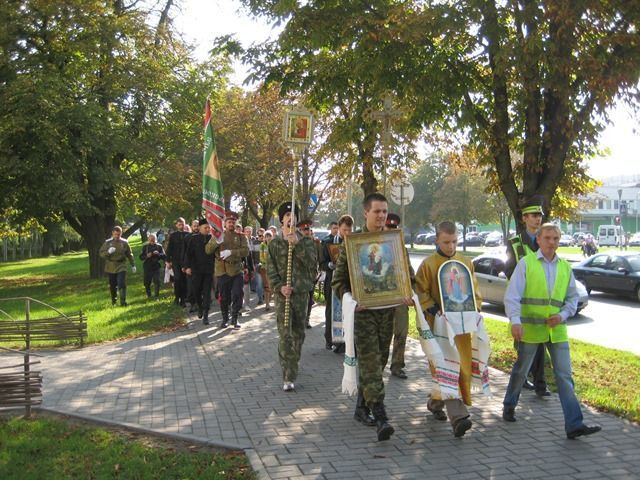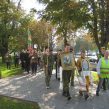
Moscow Readying Neo-Cossacks of Belarus for Use Against Lukashenka
Publication: Eurasia Daily Monitor Volume: 12 Issue: 84
By:

Moscow has had little or no success in mobilizing ethnic Russians as a whole in Belarus against the current government in Minsk: the local Russian community, in almost all cases, blends easily with the Belarusian majority. But there is one group within that community with which the Russian authorities appear to have had greater success—the small neo-Cossack groups in Belarus. And this effort deserves attention because these people might well be the surrogate “little green men” Moscow would deploy if it invades Belarus as it has Ukraine—a group that the Russian government would certainly claim was indigenous to Belarus but that, in fact, would not exist were it not for Moscow’s sponsorship.
Although tsarist forces deployed Cossack units on the territory of what is now Belarus—notoriously, in the case of anti-Jewish pogroms in the Pale of Settlement—that area was not part of the traditional lands of any of the 13 Cossack hosts that existed prior to 1917. Consequently, the Cossack groups that have emerged in Belarus over the last two decades are not so much the revival of an earlier tradition, but rather they form a part of the neo-Cossack movement: a grouping close to the police and security services of the Russian government that has adopted Cossack forms and symbols, but which has little in common with the broader Cossack revival across the former Soviet space, except for the name.
Unlike neo-Cossack groups in the Russian Federation, the neo-Cossacks in Belarus are particularly small, numbering no more than a few hundred in any one group and a few thousand overall. Some are registered with the Belarusian authorities, but most, it appears, are not and operate mainly below the radar screen of the government. Much like their Russian counterparts, the Belarusian neo-Cossacks are highly fragmented—most have formed from the splintering of other groups because of personality clashes—and continue to exist largely because of the support they receive from Russian security agencies. Last fall, for example, it became known that some of the most prominent Belarusian neo-Cossacks were attending special military camps organized by the Russian spetsnaz (special operations forces) airborne troops (Charter97, October 28, 2014).
And the neo-Cossacks of Belarus might have remained an exotic phenomenon, of interest to those studying social mobilization and syncretic identities but not to a broader audience, were it not for three things: First, there is the Ukrainian precedent and the fact that at least some neo-Cossacks have gone to Donbas (eastern Ukrainian region encompassing Donetsk and Luhansk provinces) to fight for pro-Moscow groups. Others in this community have seen such actions as heroic and a possible model for themselves in Belarus in the future (Belaruspartisan.org, April 29).
Second, there was the statement by Igor Strelkov, the quondam leader of the so-called “Donetsk People’s Republic” about Belarus that caused some to think that he planned to expand his base of operations into Belarus. In a VK post on February 16, Strelkov wrote: “Whether Lukashenko wants this or not, there is being created around him a new so-called Litvin identity, which, in my view, is no less harmful than Ukrainianism. But Belarus was, is and will remain part of the Russian world” (VK, accessed May 5).
And third, the increasing tensions between Vladimir Putin and Alyaksandr Lukashenka over Ukraine and other issues have led Belarusians and others to ask, as Sergey Zhelud wrote in in an article for the independent Belarusian newspaper, “Salidarnasts” on April 29, “on just what positions do Cossacks in Belarus stand?” And further, “do they represent a potential threat to the independence” of Belarus as a country (Gazetaby.com, April 29)?
Zhelud’s answers are not reassuring as far as the future is concerned. He points out that Belarus’s Cossack groups are fragmented: some are hyper-loyal to Lukashenka and his regime while others insist that Belarusians are not a separate nation and thus are loyal to Moscow. This state of affairs provides Moscow the opportunity to confuse the situation if it chooses to use the Cossacks against Minsk. The Belarusian Cossack organization, for example, has expelled some of the leaders of the radical groups and remains loyal to Minsk. Moreover, Zhelud says, many of the leaders of the smaller groups have criminal records—sometimes for anti-Semitism and sometimes for ordinary crimes—as well as ties to the Russian security services, a worrisome combination on public view in Crimea and Donbas over the last year. And he notes that unregistered neo-Cossack groups continue to engage in military training exercises outside of Minsk and Gomel, most recently in the last month, and show sympathy for Donbas fighters.
Those are precisely the kinds of troubled waters in which Vladimir Putin has shown he likes to fish. Sowing confusion about who is involved in any attack buys him time to achieve many of his goals. At the same time, the criminal backgrounds of some of those involved, combined with their unregistered status, give him a whip hand in deciding when to deploy them and how. Consequently, while the neo-Cossacks of Belarus may not seem like a significant force now, they could be a bellwether for Moscow’s actions against Minsk in the near future.




